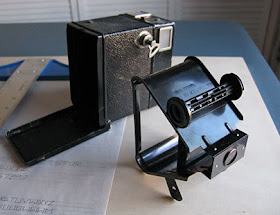I shot a roll of TMAX 100 this morning in the JEM JR. 120. I had forgotten what a quirky camera it is.
There was a lot of flare to contend with in all the images from the JEM, and I had to make some considerable contrast adjustments to get anything usable. It occurred to me after the fact that a lot of the flare was probably being created by the cover plate in front of the lens; some improvement could likely be gained from removing the largely decorative glass from the front of the camera. The real lens is quite far back behind the shutter, so it should actually be pretty well shielded from flare.
There is a manual available on the Butkus site for the JEM JR., but it has quite a bit of misleading information about the camera's features. The manual states that the cameras shutter speed is 1/25 and the aperture is a fixed f16. It then suggests that ASA 50 film be used in bright sun; of course that is going to yield a stop over-exposure. A warning is included that the photographer should stay at least six feet from the subject, but that is wrong as well. As shown on any of the on line depth of field calculators, the hyperfocal distance for a 90mm lens at f16 is about 24 feet, with the closest sharp focus at 12 feet. While the expectation was that images from the camera would only be destined for contact prints, it still seems very optimistic to expect anything to look sharp at six feet from the camera.





With all these quirks, is this camera worth another try?
ReplyDeleteYou've got it right, of course. What would be interesting about an old camera with no quirks? I put another roll of TMAX in the camera, and I've pried out the cover glass just in case.
ReplyDelete